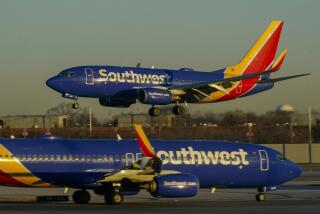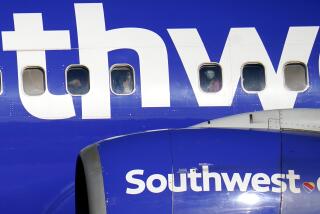Fight Over Right to Smoke in Flight
The stewardesses on the TWA L-1011 flight between St. Louis and Los Angeles were fuming. It was a crowded flight and there were few empty seats. The smoking section in the rear of the plane was full. The problem was that everyone in that section was smoking.
Less than 20 minutes into the flight the air was so bad that the flight attendants drew straws to see who would be doomed to work the section. Other passengers, sensitive to the smoke now drifting into the nonsmoking cabin, elected to stand toward the front of the coach section. Even the rear lavatories were outrageously smoky, and complaining passengers were given permission to use the first-class lavatories. On final approach, when the captain switched on the no-smoking sign, some passengers applauded.
The TWA flight is not an isolated case. The smoking issue has clearly become one of the more emotional (and in some cases, physically violent) issues in transportation today, pitting passengers against carriers--and each other.
The battle lines have been drawn in the skies between compulsive smokers and the equally compulsive nonsmokers, known alternately as “born-again breathers.” It has not been a quiet fight.
A Number of Brawls
In-flight cabin brawls have erupted on a number of occasions. In 1979 a notorious fight broke out on the Eastern Airlines shuttle from Washington to New York. A last-minute boarding passenger, an attorney, demanded a nonsmoking seat. When the nonsmoking section of the plane was extended to accommodate him, the smokers already in that area protested.
The argument quickly developed into a shouting match, then a shoving match, followed by nothing less than an all-out brawl. The crew was unable to stop the out-of-control clash over cabin territory, so the captain declared an on-board “insurrection” and made an emergency landing in Baltimore.
Since then dozens of in-flight fights have broken out and virulent anti-smokers have been escorted from a host of planes; stewardesses have been assaulted by smoking and nonsmoking combatants. On one British Airways Concorde flight, a well-to-do smoker was punched in the nose when he refused to put out his cigarette. A few weeks later the captain of a United 747 bound for Los Angeles was able to calm down the non-puffers only when he threatened to make an unscheduled stop.
A United Airlines stewardess put on a gas mask to make a nonsmoking statement on a Honolulu flight while serving dinner in the smoking section.
The fights have not been restricted to the cabins. A smokers/nonsmokers fight broke out in San Diego among PSA passengers at an airport lounge as they were waiting to board a flight. And on an Eastern Airlines flight, the co-pilot complained to the captain about his incessant smoking. When the pilot refused to stop, the first officer reached up and pulled down his oxygen mask. The captain told him to remove it. He refused and continued to wear it throughout the flight. He was later reprimanded by the airline for disobeying the captain’s order.
Professor of Law
Who’s winning the big smoking battle? One person who thinks he knows is John Banzhaf. Banzhaf is a professor of law at George Washington University. He’s also executive director of ASH (Action on Smoking and Health), the Washington, D.C.-based legal action arm of the anti-smoking community.
ASH started in 1968, when Banzhaf successfully petitioned the FCC to require television and radio stations to broadcast anti-smoking messages. In 1972 ASH declared war on the airlines. Banzhaf asked the Civil Aeronautics Board, the federal agency then charged with making--and enforcing--smoking regulations, to institute nonsmoking sections aboard aircraft. The CAB agreed, requiring U.S. airlines to allocate those sections.
“It was a start,” Banzhaf says, “but only 30% to 40% of the seats were designated for nonsmoking.” If you didn’t get a nonsmoking seat, you were out of luck.
In 1975 ASH, as well as Ralph Nader, were before the CAB again, this time asking for a ban on in-flight cigarette, cigar and pipe smoking. They also argued for a ban from the FAA on smoking in the cockpit, claiming that smoke adversely affected nonsmoking crew members, affected visual perception, night vision and reflexes. The FAA denied the petition. Nader went to court to appeal the decision. He lost.
But the CAB did change some of the regulations. It ordered airlines to expand the nonsmoking section. A passenger was then given the right to a no-smoking seat. The CAB further ruled that smoking on board planes not be permitted unless all ventilation systems were operating.
This rule was specifically aimed at instances in which airplanes were delayed on the ground and the captain turned off the “no-smoking” signs. Two other 1975 CAB rules seemed intentionally fuzzy. While the CAB did not ban cigar and pipe smoking, they ruled that no person should be required to smell cigar and pipe smoke. It also ruled that no person should be “unreasonably burdened” by drifting tobacco smoke.
Many airlines responded by simply banning cigars and pipes altogether. ASH responded by filing complaints against dozens of airlines in petitions before the CAB on behalf of passengers citing the “unreasonably burdened” clause.
Cabin Separation
Pan American, which had earlier reconfigured its cabin seats with a longitudinal (left to right) cabin separation between smoking and nonsmoking sections, saw the complaint rate increase 300% from passengers citing the “unreasonable burden”; the smoke was drifting from one side of the plane to the other. Pan Am quickly returned to the front/back cabin separation.
(However, other airlines such as Air Canada and Alitalia, still separate the smokers from the nonsmokers left to right.)
For one brief moment a Dallas-based airline, MUSE Air, announced that it had eliminated smoking altogether from its flights. The popular MUSE rule lasted as long as the airline did. Absorbed by once-rival SouthWest Airlines, MUSE is now called Transtar, and smoking is once again allowed.
For another brief moment, things looked even better for nonsmokers. In 1982 Richard Schweiker, secretary of Health and Human Services, got into the act. He wrote the CAB urging that nonsmokers on commercial flights should be protected “from the nuisance and in some cases the physical risk of exposure to tobacco smoke.”
The CAB wasn’t listening. The agency had decided to reconsider all smoking requirements. Two board members voted to abolish all regulations, two were in favor of the existing rules and one member was firmly on the fence. An uncomfortable compromise was reached. The CAB eliminated the “unreasonably burdened” rule as well as the ventilation requirements.
“What this meant,” Banzhaf argues, “is that as long as you were sitting in a nonsmoking section you could be choking to death from smoke and the airline would be in technical compliance with the rules.”
The ventilation problems have been compounded by a recent FAA rule change. Because of the airlines’ zeal for reducing weight, the FAA allowed many of them to remove one of three ventilator packs from their wide-bodied aircraft, thus reducing the efficiency of the aircraft’s ventilation system (and the oxygen level).
Finally, by a narrow 3-2 vote, the CAB adopted a rule that any airline passenger who arrives after the official check-in time will no longer be guaranteed a no-smoking seat.
Cabins and Courts
But the smoking fight goes on, if not in the cabins, then in the courts. In 1982 ASH sued the CAB, charging that the board had cut back on regulations without providing adequate explanations as required by law. John Banzhaf argued this case before the U.S. Court of Appeal in Washington, D.C., and, in 1984 he won, with the court also ruling that the CAB reimburse ASH for $40,000 in attorney fees.
As a result the CAB adopted new rules, including banning smoking from aircraft with 30 seats or fewer, banning cigar and pipe smoking, all smoking while an aircraft is on the ground, and reinstated the “unreasonably burdened” and aircraft ventilation regulations.
“The results have been much better,” Banzhaf says, “but by no means are we satisfied yet.” No major U.S. airline has yet banned smoking but some smaller carriers are considering it. And all the inter-island airlines in Hawaii have banned smoking.
“The rules are also much clearer now,” he says. To be sure, for a nonsmoking passenger to be denied a no-smoking seat today, the Department of Transportation (successor to the CAB) has ruled that (1) the passenger must have arrived for the flight after the official check-in time; (2) the nonsmoking section is full; and (3) the flight offered advance seat assignment.
“All three of these must happen for a passenger to be denied,” Banzhaf says, “not just one.”
ASH publishes a wallet-size card listing the DOT smoking rules and lists passenger rights in the event there’s a problem. The card is free by writing to ASH, 2013 H St. N.W., Washington D.C. 20006.
More to Read
Sign up for Essential California
The most important California stories and recommendations in your inbox every morning.
You may occasionally receive promotional content from the Los Angeles Times.









